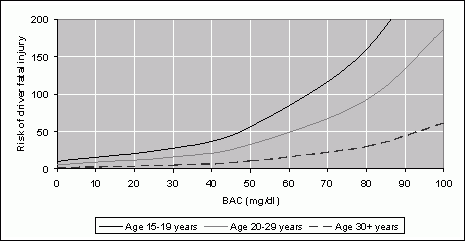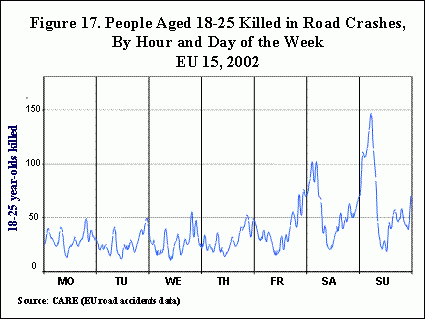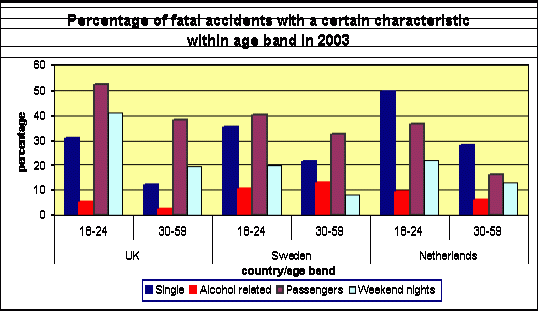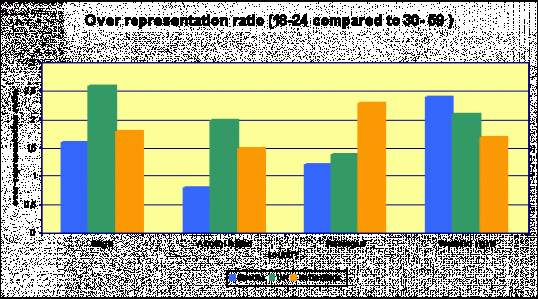Characteristics of these crashes
Characteristics of these crashes
Young novice drivers are heavily over-represented in single vehicle crashes (crashes that do not involve other vehicles) and loss of control crashes. Although young novice drivers are over-represented in crashes at all times of day, weekend evenings and nights present higher risks per kilometre driven, especially for male drivers.
For males, speeding is an important accident cause. This, in combination with the fact that young drivers often carry more passengers in their cars, also results in more severe injuries and a higher number of people injured.
Speed and single accidents
Speed and speeding is undoubtedly one of the main causes of crashes involving young drivers, particularly men (almost 30% of all causation factors for crashes involving male drivers and 21% for female drivers, compared with only 15% for older driver's crashes).
Speeding is much more likely to be a crash cause in a fatal crash when the driver is under 25 years old, the likelihood being highest for the youngest drivers. Speeding is much more prevalent for young male drivers than for young female drivers; 21 to 24 year old women have approximately the same level of involvement in speeding related fatal crashes as men aged 35 to 44. It is believed that poor speed adjustment is the reason why youngsters are over-represented in single accidents.
It should be recognized that, other than speeding, speeds which are too high for prevailing conditions are also a relevant phenomenon. In this situation, the driver does not violate the actual speed limit but gets into a crash because of an inappropriate driving speed in a traffic situation which requires a much lower driving speed. In crash registrations this is seldom documented, but driver behaviour observation studies show that inappropriate driving speeds are common in novice young drivers. Tackling this phenomenon is even more difficult than tackling the speed violations, as this behaviour is the result of an inaccurate assessment of the complexity of the driving situation. Speed violations, in contrast, are the result of a 'simple' decision to drive faster than the observed legal limit.
Alcohol and drugs
Alcohol is a key factor in young driver crashes, particularly when combined with other factors, such as speed, night time driving and carrying passengers. While young novice drivers do not necessarily drink drive more than other drivers, the consequences are often more serious.
As young people are over-represented in crash statistics, even the same proportion of alcohol-related crashes is likely to translate into a much higher absolute number of crashes and fatalities.
Furthermore, lower quantities of alcohol seem to have a somewhat stronger effect on younger driver fatality risk as is shown in Figure 2. Use of illegal drugs is on the increase as a factor in young novice drivers crashes.
Figure 2: Risk by BAC (mg/dl) and age Group:
relative to risk of sober driver aged 30 or more New Zealand (1995-2000)
Source: Adapted from Keall et al, 2004
Passengers
Young driver risk differs markedly from that of older drivers for the effect on crash risk of carrying passengers. For older drivers the crash risk decreases when they carry passengers; for 18-19 year-old drivers the risk doubles, while for 16-17 year-olds it increases by as much as 4 times, getting higher as the number of passengers increases.
As a result many youngsters are killed as passengers in a young driver crash. In the Netherlands for instance, 40% of the fatalities are passengers, and the remaining 60% are young drivers.
Time of day/ Day of week
A typical young driver accident happens in the early hours of the morning, and most frequently at weekends, as can be seen in Figure 3. Partly, this pattern is caused by the fact that youngsters do most of their driving in these hours. However, these hours are also more dangerous, because of the special driving context, such as tiredness, presence of peer passengers, and excitement.
Figure 3: Persons aged 18-25 killed in road crashes by hour and day of the week in 15 EU countries
Typical young driver crashes
To answer the question on how 'typical' young driver crashes are, or whether these accident types just reflect country specific patterns, Lynam et al [21] compared the United Kingdom, Sweden and the Netherlands on the following accident types:
- Drink driving crashes: including all crashes in which the young driver had a blood/alcohol percentage that is over the 'national ' legal limit. In the Netherlands that is above 0.5, in the UK it is over 0.8, and in Sweden it is over 0.2
- Single crashes (an accident without any other traffic involved, or collisions with non-moving objects)
- Presence of (injured/killed) passenger
- Weekend night crashes (crashes in the period Friday 08.00 pm - Saturday 06.00 am and Saturday 08.00 pm - Sunday 06.00 am).
Differences between countries
Figure 4 shows the percentage of all fatal crashes within the particular age band that is characterised by the factors mentioned for both the young drivers (18-24 years of age) and the reference group (drivers between 30-59 years of age). The sum of the proportions within an age group can be higher than 100%, as one crash can be coded in more than one category. For instance, a crash, in which an intoxicated young driver carrying passengers collides into a tree during a weekend night, is present in all 4 categories.
Figure 4: Percentage of fatal crashes that are single car crashes, alcohol related crashes, crashes in which passengers are injured or killed, and weekend night crashes in the age bands 18-24 and 30-59
First of all, Figure 4 shows that the distribution of accident types is very similar for both novice drivers and expert drivers, indicating country specific problems. This asks for a broad approach, not only targeting young drivers. For instance, the percentage of single car crashes for both age bands is considerably higher in the Netherlands than in the other two countries. Particularly the Swedish drivers between 30 and 59 years of age have noticeably more alcohol related fatal crashes than the same group of drivers in the UK or the Netherlands. Compared to the UK, fatal crashes in which passengers are injured or killed are relatively rare in the Netherlands, and fatal crashes in weekend-nights happen much more frequently in the UK than in Sweden or the Netherlands.
Beside these country specific patterns, the percentages in the 18-24 age bands are higher than in the 30-59 age bands in all 3 countries. The only exception is the percentage of alcohol related fatal crashes in Sweden. This percentage is slightly higher for the 30-59 age bands than for the 18-24 age bands.
Differences within countries
To compare older and younger drivers within each country, over-representation ratios were calculated (Figure 5). Values > 1 indicate an overrepresentation of young drivers in an accident type, while values < 1 indicate an under-representation.
Figure 5: The ratio between the percentages of an accident type in the 18-24 age bands and the 30-59 age bands
Figure 5 shows young novice drivers to be relatively over-represented in single car crashes, fatal alcohol related crashes, fatal crashes in which passengers are injured or killed and fatal weekend night crashes compared with older more experienced drivers. Only in Sweden young novice drivers involved in fatal alcohol related crashes are under-represented (over-representation ratio slightly less than 1). The over-representation of fatal weekend night crashes for young novice drivers is quite similar between the 3 countries. The over-representation of fatal single car crashes in which young novice drivers are involved, is remarkably higher in the UK than in the other 2 countries. Compared to the 30-59 age bands, the 18-24 age bands in the Netherlands is more over-represented in fatal crashes with passengers, than is the case in the UK and in Sweden




